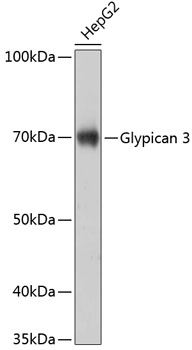Cell Biology Antibodies 16
Anti-Glypican 3 Antibody (CAB11686)
- SKU:
- CAB11686
- Product Type:
- Antibody
- Reactivity:
- Human
- Host Species:
- Rabbit
- Isotype:
- IgG
- Antibody Type:
- Monoclonal Antibody
- Research Area:
- Cell Biology
Description
| Antibody Name: | Anti-Glypican 3 Antibody |
| Antibody SKU: | CAB11686 |
| Antibody Size: | 20uL, 50uL, 100uL |
| Application: | WB IF |
| Reactivity: | Human |
| Host Species: | Rabbit |
| Immunogen: | A synthesized peptide derived from human Glypican 3 |
| Application: | WB IF |
| Recommended Dilution: | WB 1:500 - 1:2000 IF 1:50 - 1:200 |
| Reactivity: | Human |
| Positive Samples: | HepG2 |
| Immunogen: | A synthesized peptide derived from human Glypican 3 |
| Purification Method: | Affinity purification |
| Storage Buffer: | Store at -20°C. Avoid freeze / thaw cycles. Buffer: PBS with 0.02% sodium azide, 0.05% BSA, 50% glycerol, pH7.3. |
| Isotype: | IgG |
| Sequence: | Email for sequence |
| Gene ID: | 2719 |
| Uniprot: | P51654 |
| Cellular Location: | Cell membrane, Extracellular side, GPI-anchor, Lipid-anchor, Secreted, extracellular space |
| Calculated MW: | 66kDa |
| Observed MW: | 70KDa |
| Synonyms: | GPC3, DGSX, GTR2-2, MXR7, OCI-5, SDYS, SGB, SGBS, SGBS1 |
| Background: | Cell surface heparan sulfate proteoglycans are composed of a membrane-associated protein core substituted with a variable number of heparan sulfate chains. Members of the glypican-related integral membrane proteoglycan family (GRIPS) contain a core protein anchored to the cytoplasmic membrane via a glycosyl phosphatidylinositol linkage. These proteins may play a role in the control of cell division and growth regulation. The protein encoded by this gene can bind to and inhibit the dipeptidyl peptidase activity of CD26, and it can induce apoptosis in certain cell types. Deletion mutations in this gene are associated with Simpson-Golabi-Behmel syndrome, also known as Simpson dysmorphia syndrome. Alternative splicing results in multiple transcript variants. [provided by RefSeq, Sep 2009] |
| UniProt Protein Function: | GPC3: Cell surface proteoglycan that bears heparan sulfate. Inhibits the dipeptidyl peptidase activity of DPP4. May be involved in the suppression/modulation of growth in the predominantly mesodermal tissues and organs. May play a role in the modulation of IGF2 interactions with its receptor and thereby modulate its function. May regulate growth and tumor predisposition. Defects in GPC3 are the cause of Simpson-Golabi-Behmel syndrome type 1 (SGBS1); also known as Simpson dysmorphia syndrome (SDYS). SGBS is a condition characterized by pre- and postnatal overgrowth (gigantism) with visceral and skeletal anomalies. Belongs to the glypican family. |
| UniProt Protein Details: | Protein type:Membrane protein, GPI anchor; Motility/polarity/chemotaxis Chromosomal Location of Human Ortholog: Xq26.1 Cellular Component: extracellular space; proteinaceous extracellular matrix; lysosomal lumen; anchored to plasma membrane; integral to plasma membrane; Golgi lumen; plasma membrane Molecular Function:heparan sulfate proteoglycan binding; protein binding Biological Process: phototransduction, visible light; anatomical structure morphogenesis; glycosaminoglycan metabolic process; negative regulation of peptidase activity; pathogenesis; positive regulation of endocytosis; osteoclast differentiation; embryonic hindlimb morphogenesis; body morphogenesis; bone mineralization; chondroitin sulfate metabolic process; positive regulation of glucose import; glycosaminoglycan biosynthetic process; glycosaminoglycan catabolic process; ureteric bud branching; negative regulation of smoothened signaling pathway; carbohydrate metabolic process; positive regulation of protein catabolic process; positive regulation of smoothened signaling pathway; retinoid metabolic process; positive regulation of BMP signaling pathway; negative regulation of growth; anterior/posterior axis specification; negative regulation of epithelial cell proliferation; lung development Disease: Simpson-golabi-behmel Syndrome, Type 1; Wilms Tumor 1 |
| NCBI Summary: | Cell surface heparan sulfate proteoglycans are composed of a membrane-associated protein core substituted with a variable number of heparan sulfate chains. Members of the glypican-related integral membrane proteoglycan family (GRIPS) contain a core protein anchored to the cytoplasmic membrane via a glycosyl phosphatidylinositol linkage. These proteins may play a role in the control of cell division and growth regulation. The protein encoded by this gene can bind to and inhibit the dipeptidyl peptidase activity of CD26, and it can induce apoptosis in certain cell types. Deletion mutations in this gene are associated with Simpson-Golabi-Behmel syndrome, also known as Simpson dysmorphia syndrome. Alternative splicing results in multiple transcript variants. [provided by RefSeq] |
| UniProt Code: | P51654 |
| NCBI GenInfo Identifier: | 2599578 |
| NCBI Gene ID: | 2719 |
| NCBI Accession: | |
| UniProt Related Accession: | P51654,Q2L880,Q2L882,Q53H15,Q8IYG2 |
| Molecular Weight: | 65,563 Da |
| NCBI Full Name: | glypican 3 |
| NCBI Synonym Full Names: | glypican 3 |
| NCBI Official Symbol: | GPC3 |
| NCBI Official Synonym Symbols: | SGB; DGSX; MXR7; SDYS; SGBS; OCI-5; SGBS1; GTR2-2; GPC3 |
| NCBI Protein Information: | glypican-3; secreted glypican-3; glypican proteoglycan 3; intestinal protein OCI-5; heparan sulphate proteoglycan |
| UniProt Protein Name: | Glypican-3 |
| UniProt Synonym Protein Names: | GTR2-2; Intestinal protein OCI-5; MXR7 |
| Protein Family: | Glypican |
| UniProt Gene Name: | GPC3 |
| UniProt Entry Name: | GPC3_HUMAN |







